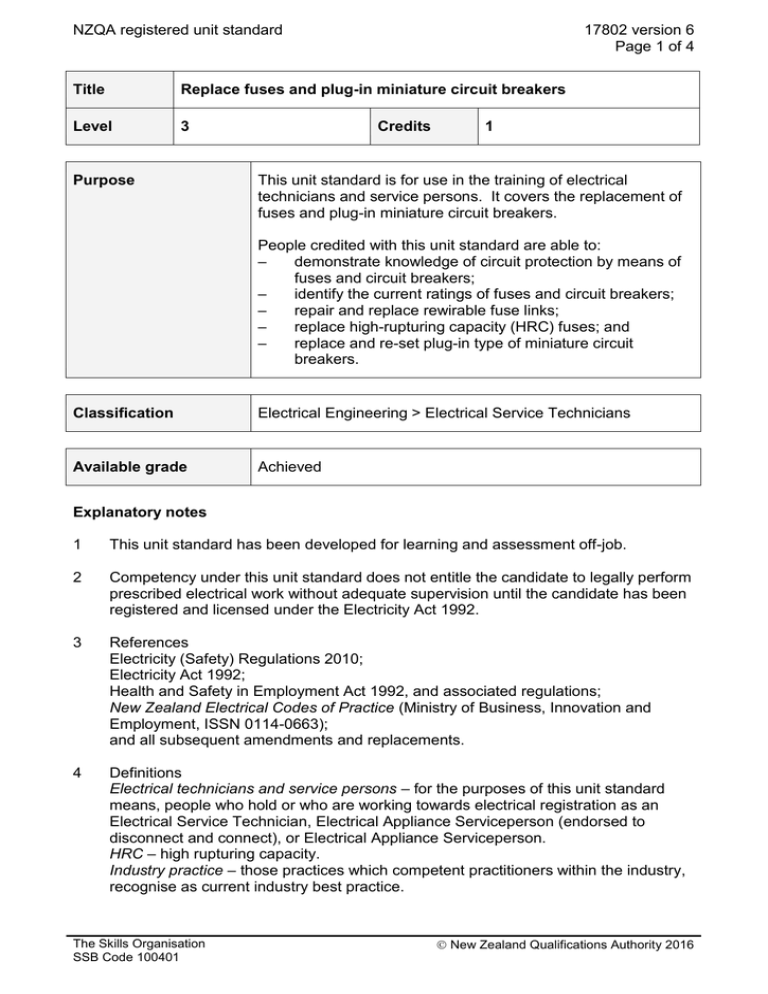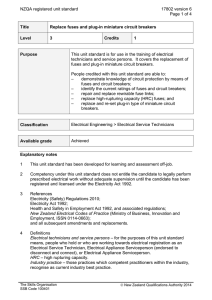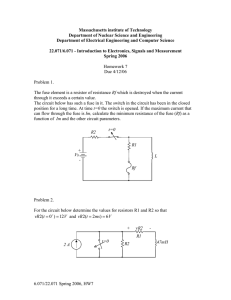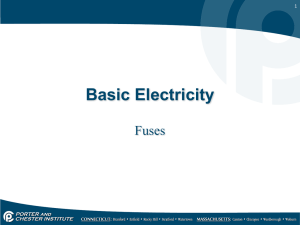NZQA registered unit standard 17802 version 6 Page 1 of 4
advertisement

NZQA registered unit standard 17802 version 6 Page 1 of 4 Title Replace fuses and plug-in miniature circuit breakers Level 3 Purpose Credits 1 This unit standard is for use in the training of electrical technicians and service persons. It covers the replacement of fuses and plug-in miniature circuit breakers. People credited with this unit standard are able to: – demonstrate knowledge of circuit protection by means of fuses and circuit breakers; – identify the current ratings of fuses and circuit breakers; – repair and replace rewirable fuse links; – replace high-rupturing capacity (HRC) fuses; and – replace and re-set plug-in type of miniature circuit breakers. Classification Electrical Engineering > Electrical Service Technicians Available grade Achieved Explanatory notes 1 This unit standard has been developed for learning and assessment off-job. 2 Competency under this unit standard does not entitle the candidate to legally perform prescribed electrical work without adequate supervision until the candidate has been registered and licensed under the Electricity Act 1992. 3 References Electricity (Safety) Regulations 2010; Electricity Act 1992; Health and Safety in Employment Act 1992, and associated regulations; New Zealand Electrical Codes of Practice (Ministry of Business, Innovation and Employment, ISSN 0114-0663); and all subsequent amendments and replacements. 4 Definitions Electrical technicians and service persons – for the purposes of this unit standard means, people who hold or who are working towards electrical registration as an Electrical Service Technician, Electrical Appliance Serviceperson (endorsed to disconnect and connect), or Electrical Appliance Serviceperson. HRC – high rupturing capacity. Industry practice – those practices which competent practitioners within the industry, recognise as current industry best practice. The Skills Organisation SSB Code 100401 New Zealand Qualifications Authority 2016 NZQA registered unit standard 17802 version 6 Page 2 of 4 Outcomes and evidence requirements Outcome 1 Demonstrate knowledge of circuit protection by means of fuses and circuit breakers. Evidence requirements 1.1 The effects of electrical faults are described in terms of the danger to people and property. Range faults – leakage current, over current, short circuit; effects – electromechanical energy, heat energy, damaged cables and equipment, fire, explosion, electric shock. 1.2 The need for rapid disconnection of faulty circuits is explained, and how this is achieved by the use of fuses and circuit breakers. 1.3 The terms current rating and fusing current are explained in accordance with industry practice. 1.4 The differences between rewirable fuses, cartridge fuses, HRC fuses, and miniature circuit breakers are explained in terms of construction, operation, and relative advantages. 1.5 The importance of using a replacement fuse or circuit breaker with the correct current rating is explained, with reference to the effects of under-rating and over-rating. 1.6 Fuses which may be repaired are identified, and reasons given as to why others must not be repaired. 1.7 An explanation is given of the procedure to be followed if a fuse or circuit breaker operates a second time in response to the same fault. Range leave circuit isolated at fuse or circuit breaker, apply tag, remove appliance from service and have it repaired, if necessary call an electrician. Outcome 2 Identify the current ratings of given fuses and circuit breakers. Range rewirable fuse carrier, cartridge type fuse, HRC fuse, plug-in miniature circuit breaker. Evidence requirements 2.1 The current rating of each device is identified from examination of markings and/or manufacturers' data. The Skills Organisation SSB Code 100401 New Zealand Qualifications Authority 2016 NZQA registered unit standard 17802 version 6 Page 3 of 4 Outcome 3 Repair and replace rewirable fuse links. Evidence requirements 3.1 Defective appliance is disconnected, and main switch turned off before removal of fuse carrier if possible. 3.2 Fuse carrier is cleaned of fragments of old fuse wire. 3.3 Fuse wire matches the current rating marked on the carrier, and is repaired according to industry practice. 3.4 After reinsertion, the fuse carrier is free of protruding ends of fuse wire, and is fully seated in its base. Outcome 4 Replace HRC fuses. Evidence requirements 4.1 Defective appliance is disconnected, and main switch turned off before removal of carrier if possible. 4.2 Fuse cartridge is replaced in carrier with one of same size, characteristic, and rating in accordance with industry practice. 4.3 After reinsertion, the fuse carrier is fully seated in its base. Outcome 5 Replace and re-set plug-in type of miniature circuit breakers. Evidence requirements 5.1 Defective appliance is disconnected, and main switch turned off before removal of circuit breaker if possible. 5.2 Replacement circuit breaker matches the base, and has the same characteristic and rating as the original. 5.3 After reinsertion, the circuit breaker is fully seated in its base. 5.4 Circuit breaker is re-set in accordance with industry practice. Planned review date The Skills Organisation SSB Code 100401 31 December 2014 New Zealand Qualifications Authority 2016 NZQA registered unit standard 17802 version 6 Page 4 of 4 Status information and last date for assessment for superseded versions Process Version Date Last Date for Assessment Registration 1 25 November 2000 31 December 2013 Revision 2 3 April 2001 31 December 2013 Revision 3 19 May 2004 31 December 2013 Review 4 20 June 2006 N/A Rollover and Revision 5 20 September 2012 N/A Revision 6 15 January 2014 N/A Consent and Moderation Requirements (CMR) reference 0003 This CMR can be accessed at http://www.nzqa.govt.nz/framework/search/index.do. Please note Providers must be granted consent to assess against standards (accredited) by NZQA, before they can report credits from assessment against unit standards or deliver courses of study leading to that assessment. Industry Training Organisations must be granted consent to assess against standards by NZQA before they can register credits from assessment against unit standards. Providers and Industry Training Organisations, which have been granted consent and which are assessing against unit standards must engage with the moderation system that applies to those standards. Requirements for consent to assess and an outline of the moderation system that applies to this standard are outlined in the Consent and Moderation Requirements (CMR). The CMR also includes useful information about special requirements for organisations wishing to develop education and training programmes, such as minimum qualifications for tutors and assessors, and special resource requirements. Comments on this unit standard Please contact The Skills Organisation reviewcomments@skills.org.nz if you wish to suggest changes to the content of this unit standard. The Skills Organisation SSB Code 100401 New Zealand Qualifications Authority 2016





